Movie Review By: SFAM
Year: 1998
Directed by: Neill Fearnley
Written by: Wynne McLaughlin
IMDB Reference
Degree of Cyberpunk Visuals: Low
Correlation to Cyberpunk Themes: Medium
Key Cast Members:
Johnny Dalton: Jeff Fahey
Nikki Holland: Tahnee Welch
Frank Donahue: Michael Ironside
Bosch: John Neville
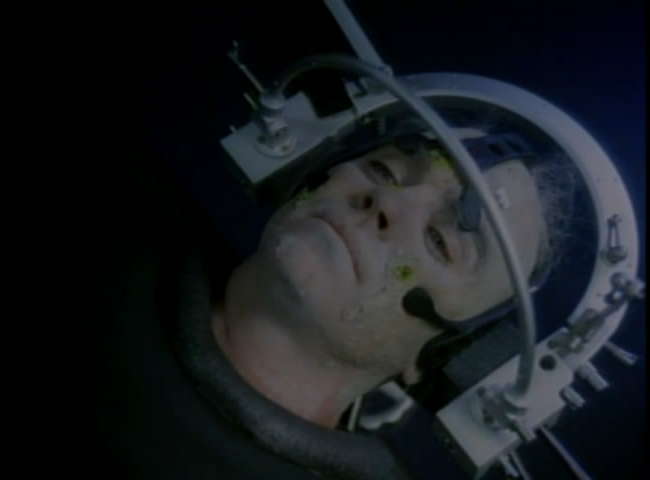
Overview: Some low-budget movies make it with a terrific story and just the right quality of effects; others come close; and others still get worried about not quite making it, so they decide to spew insane plot twists at the viewer in the hopes of increasing the tension. Unfortunately, Johnny 2.0 takes this tact. The movie was “teetering on the edge” of being decent, but fell off the wrong side. Instead of going with the stream of increasingly unbelievable plot twists, had they spent just a bit more on beefing up the story, Johnny 2.0 could have gotten some real kudos.
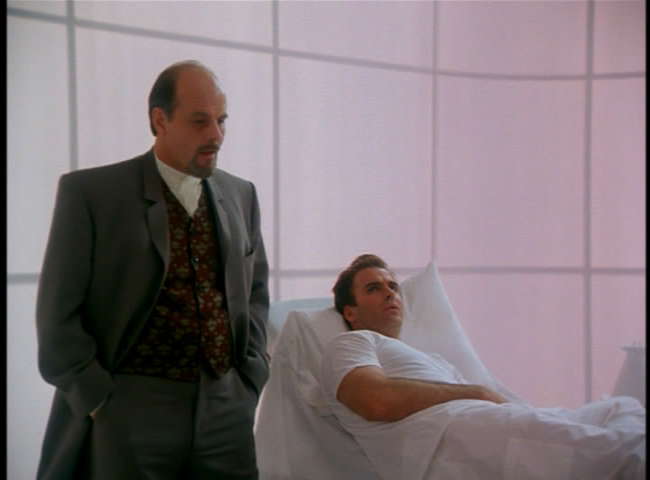
The Story: In the present, the experimentation with cloning begins to take off when scientist Johnny Dalton (Jeff Fahey) teams up with Frank Donahue (Michael Ironside) to create a small cloning start-up that has terrific potential. They are able to speed up the cloning process, and more surprisingly, are able to take an MRI scan of a person’s brain in a way that can record their entire set of memories. Unfortunately, anti-technology terrorists attack their complex and severely hurt Johnny, causing a massive, bleeding head injury.
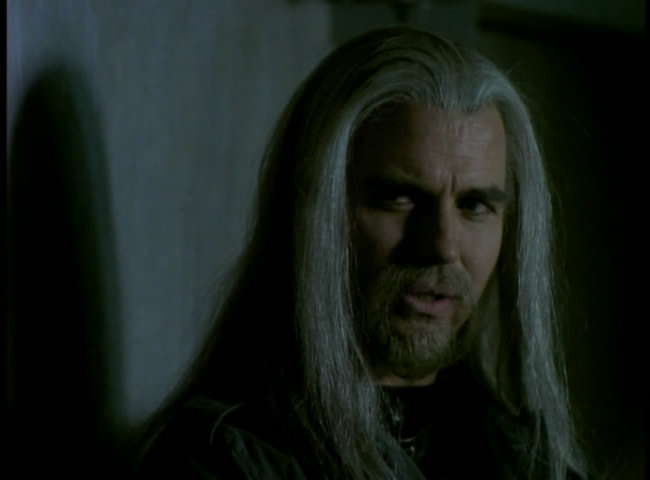
Johnny wakes up later to find that almost 20 years have passed, and that he is no longer Johnny Dalton – he’s a clone. Now referred to as “Johnny 2.0,” Johnny’s memories extend only to the injury 20 years ago when he had a scan of his memory. Now, the earth has become a dystopia, where countries have broken down, and only the corporations exist to maintain order. Worse, the “real” Johnny Dalton has either been taken by terrorists, or worse, has joined them, and has taken all his research, including a software program that removes imperfections in clones. Now, unless Johnny 2.0 can find and return the original Johnny Dalton, his body will start to break down within the week!
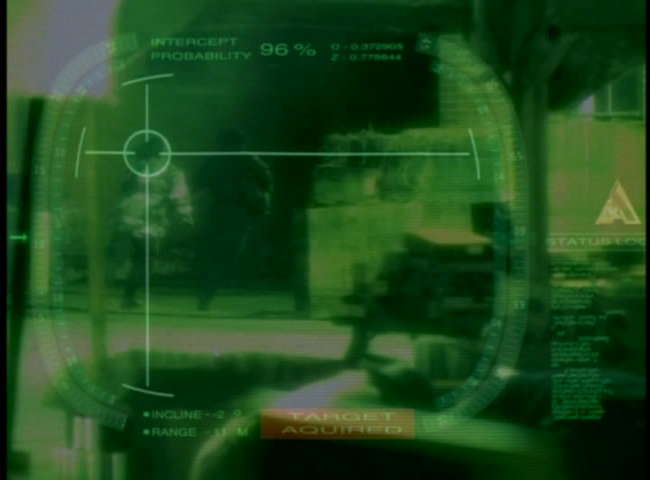
While the story starts off in an interesting way, and generally keeps a decent pacing, as things get tense, instead of resolving things in an innovative way, the viewer is continually assaulted with the most extreme plot twists. OK, one or maybe two might work, but Johnny 2.0 just doesn’t know when to leave well enough alone. Worse, in key scenes the rationale for certain characters starts to resemble the massive space invasion force surrounding Naboo in The Phantom Menace – they all seemingly took a lunch break when the counter attack came, leaving only one ship to defend their forces. When all is said and done, it’s simply not possible to suspend disbelief.
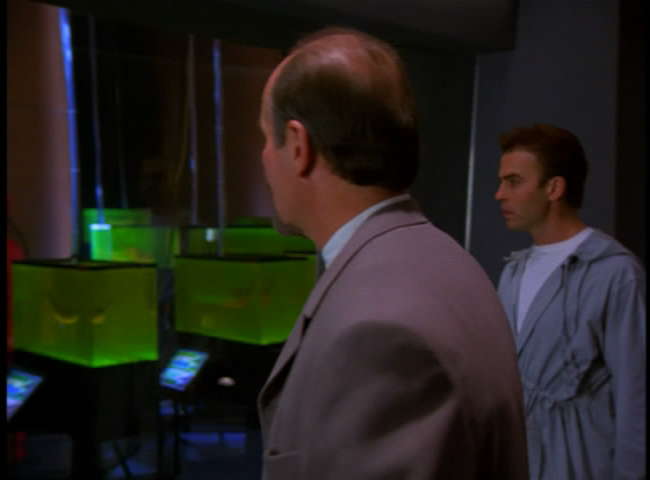
Johnny 2.0 Clone Technology Musings: For all its faults, Johnny 2.0 does have some interesting musings about cloning. The idea that clones can be sped up, and enhanced (by removing eye imperfections, improving the immune system, etc.) is interesting. More interesting is the idea that our memories can be recorded and re-inserted into a new host. Unfortunately, Johnny 2.0 doesn’t address idea with any degree of thought. In Johnny 2.0, the brain is essentially seen as an empty hard drive just waiting to be filled up with new memories. Even existing people apparently can have their memories wiped and re-inserted with new ones. Had this technology been combined with the rapid growth process, whereby a clone could be created while having their brain slowly become adapted to the imprinted memories, this would have worked lots better. Unfortunately, shortcomings in the ending narrative precluded anything unique here.
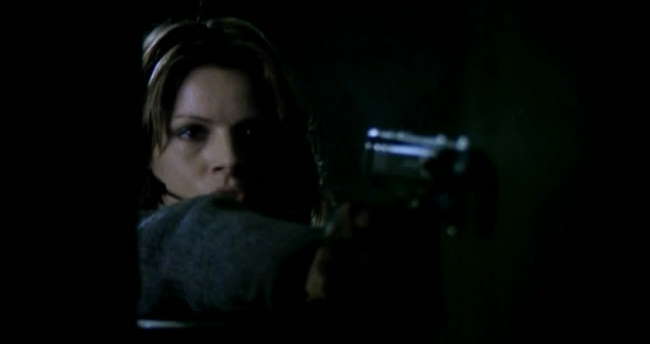
Even with the faults, Johnny 2.0 poses an interesting idea – that our existence could be perpetually extended by a combination of cloning and brain scanning. In Johnny 2.0, it’s the evil corporate head who is trying to cheat death, but if such a technology were created, one can only imagine the change we see in society. Imagine the chances we individually would take.
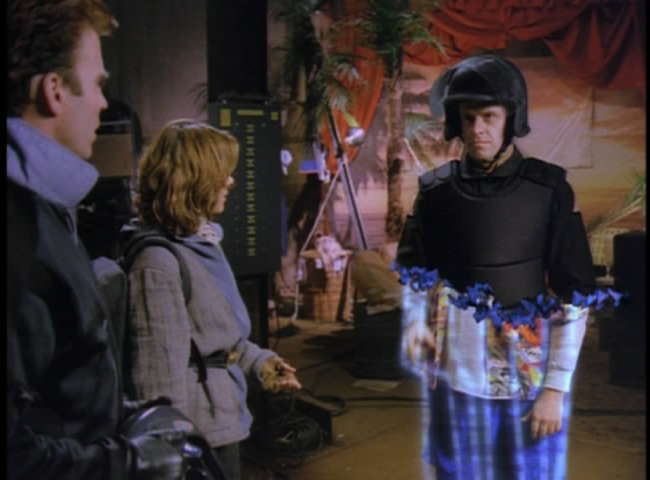
The FX: For the most part, the FX was what you’d expect – low budget TV fare. It wasn’t too distracting though, and pretty much worked for what was intended. Some of the effects, like the force field walkthrough scene was pretty forced though. One wonders why they would spend the money for a high-tech force field instead of a wall, especially when it can be penetrated so easily. They also seemed to try to stick VR helmets on everyone – this is more a sign of the times as VR stuff was hot in the mid nineties.
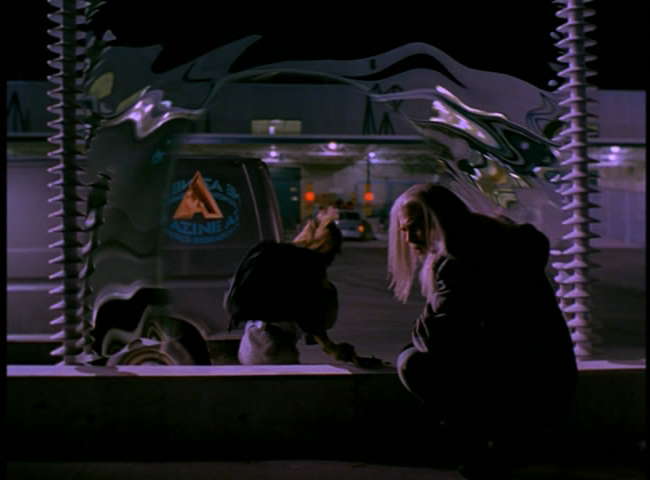
The Bottom Line: While the concept is interesting, this made for TV movie is poorly implemented. Although, there is enough here to get a modicum of enjoyment, and the movie does start off well enough that I feel compelled to give it at least a 5 star rating, especially considering it’s low budget. The actors were at least adequate (Michael Ironside of Total Recall fame was definitely the best of the bunch), so consider giving it a watch if nothing else strikes you.
~See movies similar to this one~
It’s not just cyberpunkreview.com, but seemingly everyone at my hosting ISP (including the ISP’s home page) is absolutely crawling at a snails pace. Icine.org, a fun movie discussion site that I hang out at is also hosted there (on a different server no less) and is also experiencing major access issues. My apologies - hopefully this gets fixed soon. 
This post has been filed under Site Development by SFAM.
Just a word or two on site access and growth. The month of March has continued a steep increase in site access. Overall, March statistics included:
- 8283 Visits (a “visit” is when when a person actually comes to the site and accesses one or more pages)
- 37,311 Pages viewed by people (and almost another 28,000 by search bots), which means the average person accessed 4.5 pages per visit.
- 308,961 hits (obviously graphics are most of the hits as I have many screencaps per review - also many have linked my images, which, to date I see no reason of blocking)
- Over 1000 of the visits lasted over 15 minutes, with almost 300 lasting over an hour (meaning the visitors read LOTS of movie and game reviews when they visited).
Just for perspective on growth, in February, the first full month of operation, cyberpunkreview had 4305 visits and 20,948 in page views (again, both not counting bot access). Also, Just three days ago (April 1st), cyberpunkreview for the first time had over 400 visits (April 2nd had 388 visits and April 3rd had 399 visits), so it appears that the upward trend is continuing.
International Access
The US accounted for just over 60% of all page views (meaning almost 40% of everyone accessing cyberpunkreview is from outside the US). The next highest countries in order were:
- Great Britain
- Australia
- European Union (I’m guessing many of the smaller European countries are grouped into an “eu” extension, but I really don’t know)
- Canada
- Netherlands
- Greece
- Germany
- Sweden
- China
- Poland
- Puerto Rico
- Croatia
- Romania
- Denmark
- Bulgaria
- Japan
Top Pages
Many people are accessing the site through the RSS feed. This accounted for my top page with over 4000 page views. In terms of actual pages, they are as follows:
- Ultraviolet, starring Mila Jovovich - Coming (updated) March 3! - this is true because Google still has cyberpunkreview on the first page for those searching for Mila Jovovich.
- Cyberpunk Movies by Decade
- Tetsuo - The Iron Man - many seem to come for the screencaps
- Ghost in the Shell
- Ultraviolet
- What is Cyberpunk?
- Natural City
- Armitage III
- Metropolis
- Texhnolyze
You’ll notice that most of these were among the first posts on the site. This indicates that the search engines have put these higher in search results than some of the more recent entries.
Game Reviews
One of the really cool things to occur in March was we got more reviewers on the site! Specifically, we got Metatron, Neuromancer and DannyV_El_Acme! All three have contributed wonderful game reviews - Metatron has also contributed reviews for Alien and the awesome William Gibson penned X-Files episode, Kill Switch.
In terms of game reviews, the highest accessed entry was System Shock, followed closely by I have No Mouth and I Must Scream and Deus Ex.
Book Reviews - and still looking for other reviewers!
Again, I’m truly excited about getting more reviewers on the site. I also want to thank Case for giving me some info and pictures on the Gene Generation, and for getting the director to come here and post!
Also, I’m fervently hoping to get some book reviews from David Gentle, Desirina, and others who mentioned an interest in this. I fully understand that doing a book review entails LOTS more work than a movie review, so I anticipate this taking more time. Again, if anyone who has familiarity with the genre and is interested in helping out with reviews, please drop me an email at sfam@cyberpunkreview.com. We’d love to have you join us!
I’m also looking for a resident cyberpunk Art critic. I’ve mentioned this once or twice to Budo (username ETM), who did my most awesome header, but thusfar he hasn’t bitten down. Hopefully I get someone to take this on though. I do want someone with artistic talent to do this (or someone with an art history background) - when I look at most of these, I find myself loving all of them. But perhaps art critique really can’t use a star rating system - this is OK too.
The Meatspace
The Meatspace discussion area is still growing. Just two days ago, we had 10 people on at once! There’s some pretty cool topics under way, including a list of all cyberpunk movies, so check it out if you haven’t already.
Future Plans
I’m starting to slow down a bit in my movie reviews. I don’t think I’ll be able to keep up with one a day. In part this is due to the increased amount of time I spend on my reviews. If you go to some of the earlier ones, many are lots shorter with less screencaps. At some point I intend to go back and beef some of these up (like Dark City, for instance). I find screencaps and cyberpunk musings essential for good movie reviews, and will probably continue this.
Mangas and Graphic Novels: Also, I intend to start reviewing some of the bigger cyberpunk mangas and graphic novels. I’m still thinking of the best way to review these, but I’ve already decided that the reviews will involve captures of the artwork.
More Navigation Pointers: Because the number of movies has increased substantially, the decades page is becoming a bit less useful. I intend to build a tree structure of all my navigation pages and link them within the key nav pages. So, from the Movies by Decade page, you’ll be able to get to the “Movies by Star Rating” page and the cyberpunk themes pages.
This post has been filed under Site Development by SFAM.
Movie Review By: SFAM
Year: 1999
Directed by: Chris Columbus
Written by: Isaac Asimov & Robert Silverberg (short story/Novel), Nicholas Kazan (Screenplay)
IMDB Reference
Degree of Cyberpunk Visuals: Low
Correlation to Cyberpunk Themes: Medium
Key Cast Members:
Andrew Martin: Robin Williams
Little Miss Amanda Martin/Portia Charney: Embeth Davidtz
‘Sir’ Richard Martin: Sam Neill
Rupert Burns: Oliver Platt
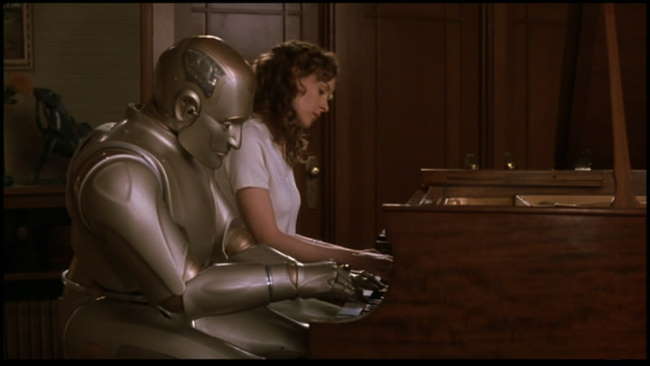
Overview: What a strange movie to try to categorize. Bicentennial Man seems like a Sci-Fi movie at times and a drama at others. In many ways, Bicentennial Man is hit or miss. Robin Williams and Embeth Davidtz are terrific, but the script itself really has trouble figuring out what movie this is going to be. Still, but there’s enough here to make it worth a viewing, as long as you don’t mind overly sappy movies.
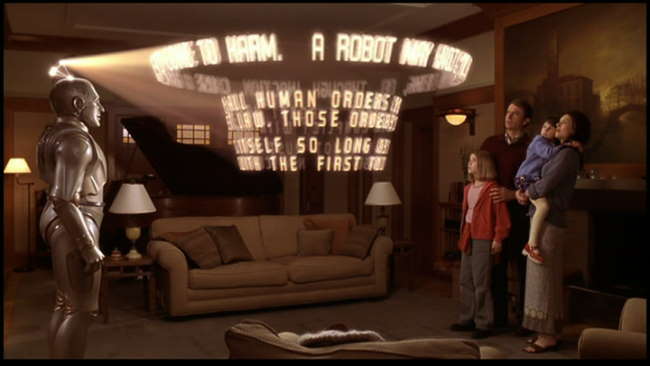
The Story: In the very recent past (2005 – but it was the near future in 1999), the Martin family has gotten a new appliance – a robot named Andrew. And while Andrew obeys the three laws of Robotics, and Andrew (Robin Williams) comes right out of the box with a sense of unexpected wonder. Andrew seems interested in all sorts of things that Robots aren’t normally interested in. In spending time with the youngest daughter, Little Miss (Embeth Davidtz), Andrew learns the meaning of love and humanity. Richard Martin, the father (Sam Neill) is intrigued by this and brings Andrew back to the corporation to talk about his “uniqueness.” The robotics maker is worried that this “bug” will ruin business and wants him terminated immediately. Luckily for Andrew, Richard likes his uniqueness, and decides to spend his time teaching Andrew everything a sentient person needs to know.
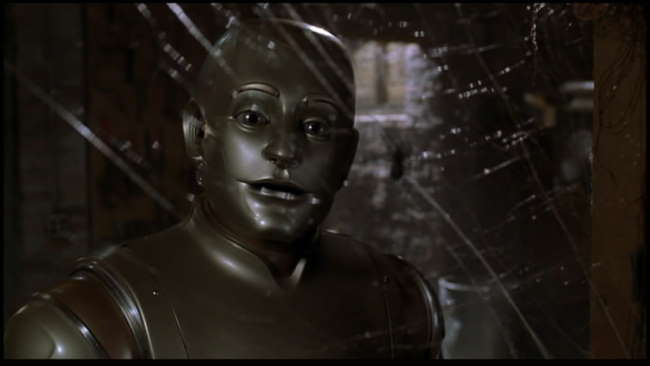
Andrew continues to grow and expand his capabilities and thinking. He becomes a master clock maker, and after working out the specifics of getting a bank account, makes millions in selling them. Time hurries on (well, not really – this part could have been edited somewhat) and Andrew’s family grows old and starts to die off. Andrew eventually asks and is granted his freedom, but still hangs around the family, especially Little Miss. He eventually goes in search of others like him, and then later finds ways of “upgrading” his appearance to become human-looking. It is at this point that he meets Little Miss’s grand daughter, Portia. He is captivated by her immediately, and begins to contemplate sharing the love with a human. But in order to do so, he decides he must be “declared” a human – this too will require change.
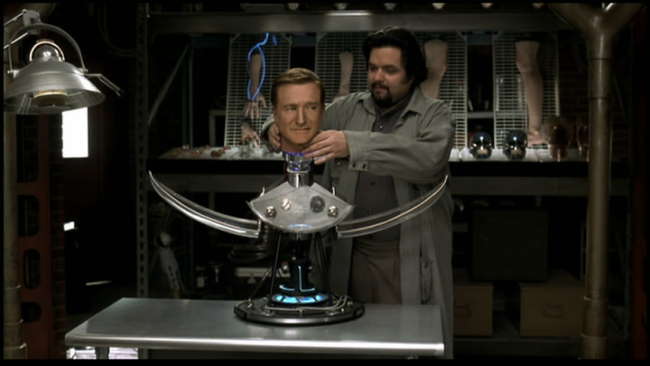
Is it cyberpunk? I was really torn about whether or not to include Bicentennial Man on this site. It clearly is not a cyberpunk movie in tone, in that the near future is closer to an idyllic situation than a dystopic one. We also don’t see a massive corporation controlling society. In fact, the story isn’t focused on society at all – it’s on an individual. So why include it in a cyberpunk site? Because of the post-human nature of the story Bicentennial Man presents us. Here we see an example of an android as a post-human versus a human transformed into a cyborg. The whole question of sentient androids and their quest for freedom and self-determination is raised and explored, although not to the extent I would have liked. In this Idyllic future, Androids are essentially still considered high-tech kitchen appliances. In its better moments, Bicentennial Man poses the question our society may face one day – when do we grant human rights to the products of our innovation? But again, I do fully appreciate that this move sits more in the gray area than it does as a cyberpunk flick.
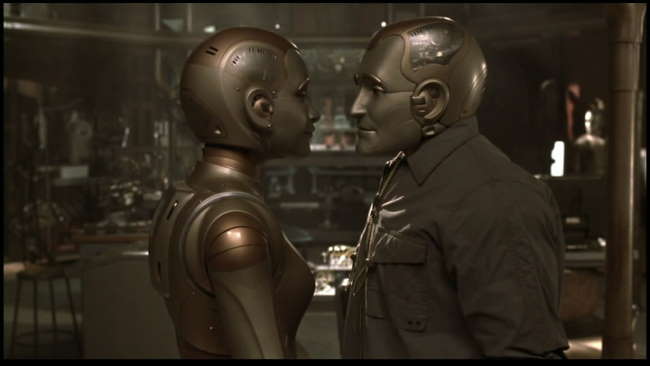
What defines humanity? One really wishes Bicentennial Man spent more time elaborating these questions instead of getting mired in a love story. While the love story was interesting and well done in an overly sappy sort of way, it is far less interesting than the question of what would make androids human. Here we have two androids – one clearly nothing more than a kitchen appliance, and the other something significantly more. Andrew has freewill, self-determination, is self-motivated, and clearly seems to “feel” love. Over time, he upgrades his body with the help of robotics tinkerer, Rupert Burns (Oliver Platt) so that he is human in virtually every way (can feel, have sex, etc.). In Bicentennial Man, Andrew pursues being declared “human” versus having human rights. Unfortunately, the movie glosses over how Andrew had the rights to maintain a bank account, own a house on the beach, or even a company. It’s clear that humanity encapsulates quite a few requirements – this movie focuses on our lack of immortality as a defining characteristic of humanity. While this may be true, it’s hardly complete. We are left with the idea that Andrew has all the other (unstated) traits but this one.
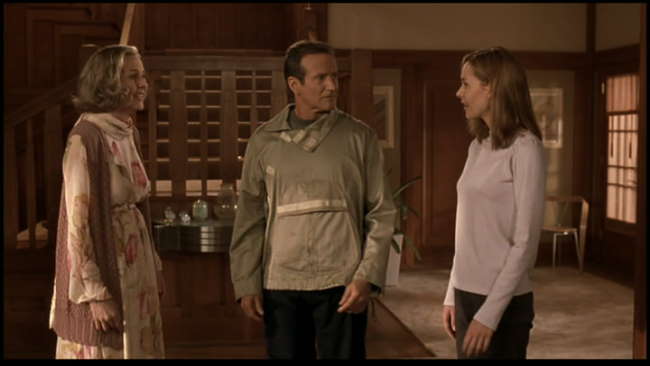
The Love Story: Bicentennial Man is a love story, and although it’s sappy, it’s still a complicated one. Andrew was really in love with Little Miss, but neither he nor her (who was also in love with him) were strong enough to admit it. Yet Andrew has another chance when her grand daughter, Portia, is an almost perfect image of Little Miss. Even then Andrew has trouble coming to terms with the possibilities. In the end, Andrew’s potential relationship with Portia represents his last step transforming to human.
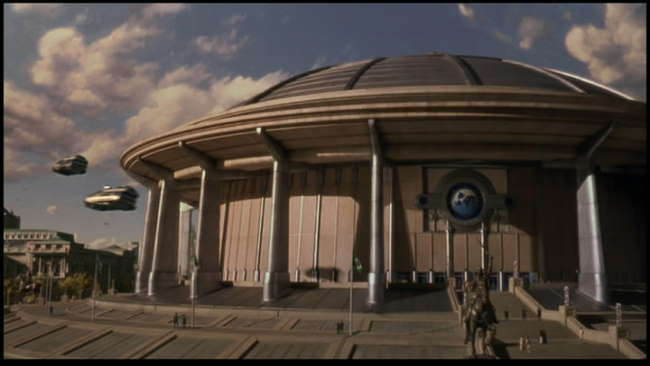
The FX: While Andrew’s expressions are well done, clearly lots more could have been undertaken here. Every so often, we get glimpses of futuristic cityscapes, but unfortunately, these appear more tacked on than integrated. Throughout most of the story, which takes place over the course of 200 years, we see no interesting change in society. Literally, the technology doesn’t seem to affect life at all. This really is an almost unforgivable lack of thought and imagination. While there was scene after scene of little love and caring vignettes, futuristic visions were pretty much non-existent here – they could have easily been integrated.
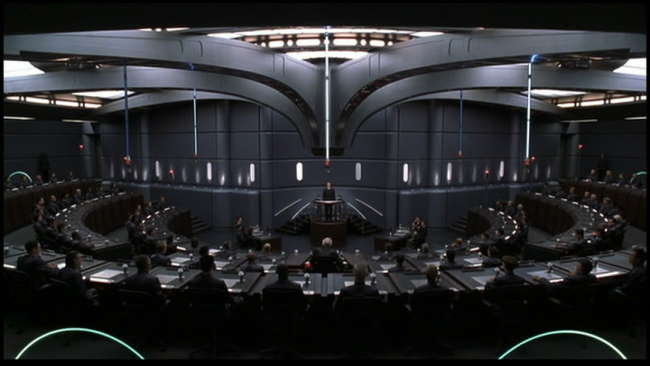
The Bottom Line: There is a number of problems with Bicentennial Man which detracts enjoyment. For starters, Andrew’s uniqueness is essentially magical, as no explanation is ever given. I would have hoped as Andrew became an inventor supreme of human and android cyborg parts, he would have spent time questioning his own existence and attempted to replicate it. Also, the length of time spent on Andrew with his family could probably have been edited down somewhat, and the time spent on the more interesting android questions and their effect on society could have been expanded. Still, there is enough here to make Bicentennial Man worth a watch. Williams and Davidtz have great chemistry and make the sappy love story work. And the questions posed are explored in at least enough detail to make you think.
~See movies similar to this one~
Game Review By: Metatron
Year: 1995
Platform: DOS
Publisher: Origin/Electronic Arts
Degree of Cyberpunk Visuals: High
Correlation to Cyberpunk Themes: Medium
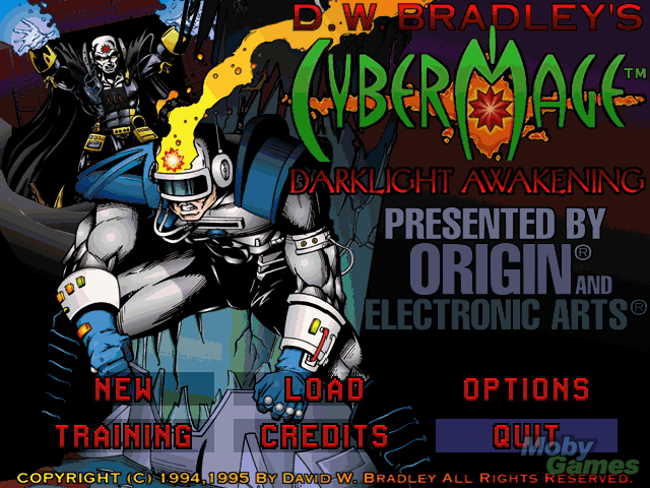
“Whoever gave me an outfit like this- I’ll sure as hell make him pay!”
Introduction: As far as hybrids go, this one has to be among the most unusual. A bizarre fusion of- as the name implies- fantasy and cyberpunk themes, Cybermage is a peculiar mutation- but one that actually works, at least to some degree. Developed by Origin (a steady purveyor of cyberpunk-related games at the time), this first-person shooter has never quite achieved the status it deserved. It was slightly overshadowed by System Shock- a spiritual predecessor of sorts- and never attracted enough attention to warrant as much as a sequel, which meant it has fallen into obscurity soon after its debut; yet it is worthy of attention both because of its unusual storyline and innovative gameplay which introduced a couple of features that would not be commonly used in other games in the genre for some time to come. Also, all screens taken from Mobygames.com
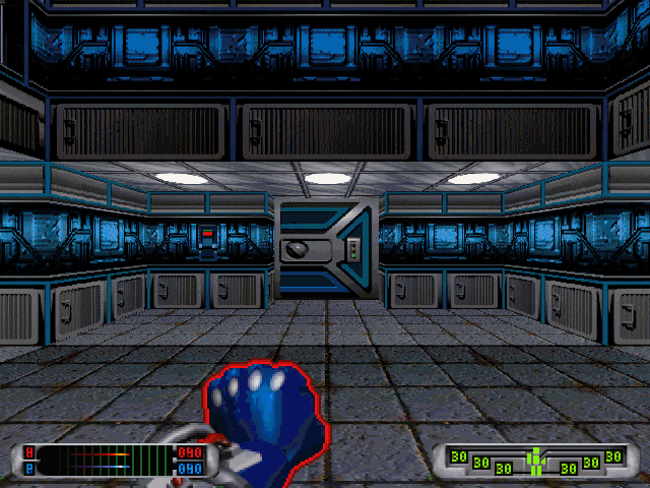
After his epic battle with Saruman, Gandalf woke up on board the Death Star…
WHEN WORLDS COLLIDE: Cybermage is a schizophrenic beast. It begins with a comic-book slideshow in lieu of a more usual intro animation, which may at first look like a lame cost-cutting exercise but is in fact crucial to the character of the whole experience. You see, Cybermage is, in part, a dark superhero story, and the comic book elements become even more pronounced as the time passes by. Once you do realise that this is a part of the package, you will learn to forgive certain strange traits, such as exaggerated graphics or cheesy character speeches. Yet this is only one part of the game’s split personality; mixed with the comic book narrative are distinct cyberpunk themes evident in both storyline and graphics- the main protagonist is, after all, a cyborg- a result of an experiment by SARCorp (hello to another nice, socially responsible corporation!) whose adventure begins in a shattered cryotube. Yet his exploits subsequently leads him not only through the more predictable cyberpunk settings such as war-torn wastlenads and assorted urban ghettos, but also slightly more unusual locales- including a sprawling Gothic sanctuary populated by fanatical death cultists. It is then that the “mage” bit comes in, leading to some almost comical theme clashes. You have to admit that bombarding the area with explosives one minute and then spraying it with magical projectiles the next can feel a bit like quickly changing channels between Lord of the Rings and Aliens. Yet the overall feel of the game is actually quite consistent, as Gothic and dark future themes do have a peculiar ability to go hand in hand, sharing what one could refer to as certain aesthetic and spiritual core values. It didn’t bother me an awful lot back where the game first appeared, but then I didn’t really pay that much attention to thematic consistency or other highbrow stuff like that anyway. More frags was all that mattered. Simple days…
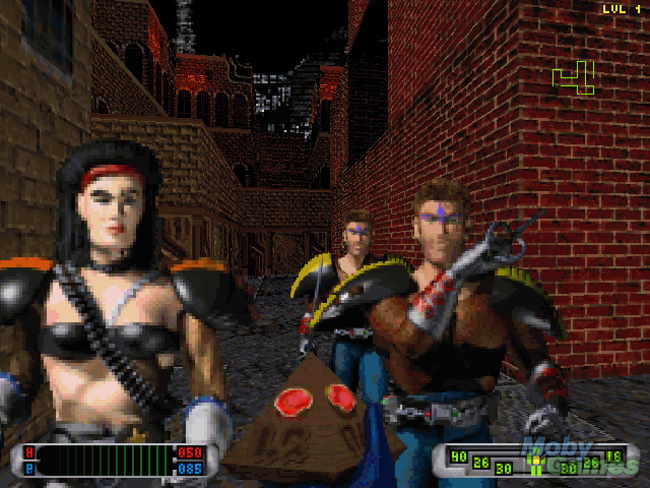
And lo, the sinister pixel-phantoms of death! The artifact in our character’s hand looks as if he nicked it from a souvenir store in Giza, but it is in fact a weapon more than capable of getting rid of tatooed thugs and bodybuilder chicks like these…
REBORN: Our journey begins in an underground lab, where our character has spent a while being enhanced and reconstructed so that he could finally begin his life anew. Yet it seems that becoming a cross between Robocop and Gandalf the Gray, clad in an outfit of a bad Power Rangers copycat pissed him off a bit- so on he went, slaughtering corporate vassals and butt-ugly mutants like there was no tomorrow. The actual story is of course more complicated than that- involving a helpful guardian-angel sorceress Earthmother and a mysterious crystal embedded in our man’s tacky rugby helmet- but the no-spoiler rule and overall vague recollection of the plot mean that I’ll stop at this point. Suffice it to say that the enigmatic leader of the unlovely corporate monolith that is out to get us- the aptly named mr. NeCrom- will stop at nothing to reduce our superhero to a piece of scrap and molten tissue, and so the only option is to ensure he suffers this very fate himself.
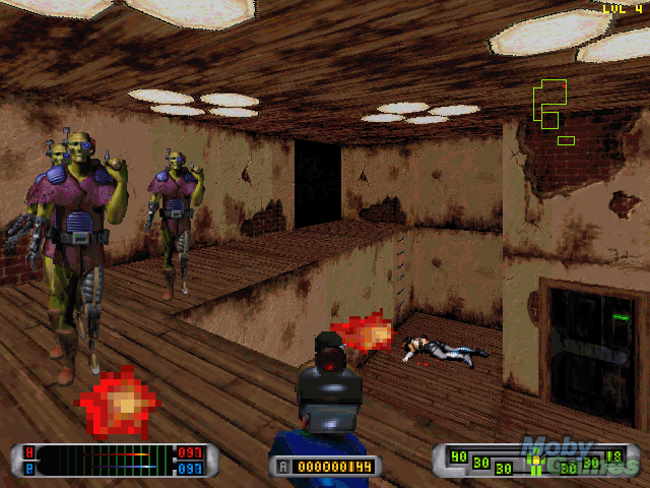
Cyber Orcs? Don’t ask me… Those red things are fireballs by the way, not display glitches.
This will be no mean feat. SARCorp is a massive entity involved both in hi-tech experimentation and dabbling in the occult, resulting in a steady stream of murderous thugs of various sorts opposing our progress wherever we go. Along the way we will have the pleasure of smacking down overzealous satanist monks, vicious mobsters, dumb zombies and a dazzling array of android assassins. In addition, we will often find alongside allies, who are generally quite helpful as even when they can’t shoot straight, they will at leas draw some enemies away. Their inclusion is also cool in that it greatly enhances immersion- the world of the game feels much more alive when populated by NPCs rather than being some imaginary Gehenna where the only righteous man left standing is yourself. NPCs will often engage you in dialogue, revealing subsequent goals and plot issues, and sometimes letting us increase our arsenal. Due of our character’s Terminator-meets-Saruman nature the weaponry used will be more than varied, ranging from missile launchers to fireballs; what’s more, we will also have a chance to fly about in a levitating aircar or better still, hop inside a small tank, which inevitably results in a handsome carnage of enemy infantry. And after we slaughter the corporate stormtroopers with high-velocity shells, we may jump out of the tank to harvest their souls, visible as bluish spectral phenomena hovering above dismembered corpses, which is useful for regenerating our mana. You’ll get more of this schizophrenic design as you go on, including scorching hordes of cyborgs with malevolent sorcery of yours, or peppering robed wizards with plasma blasts if you wish to. At some point we even meet a bizarre military figure with a tiger-like looks which, given that Origin also made the Wing Commander flight sim, made me think that he was some kind of fugitive Kilrathi. Pure conceptual insanity.
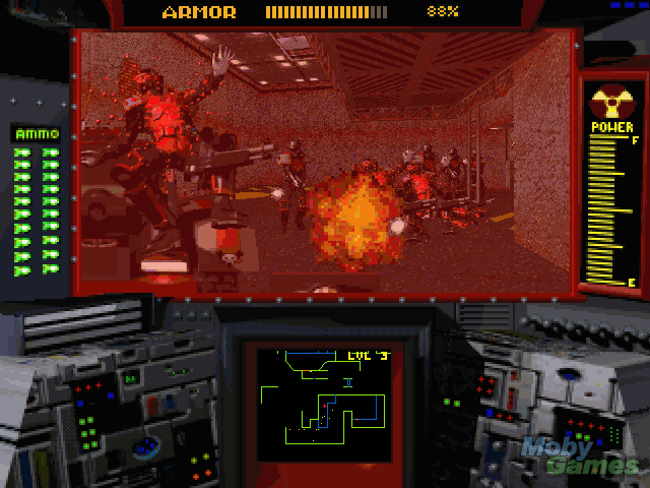
A reminder: never leave the keys to your tank in the vehicle…
What is even more astonishing is that there seems to be a method in this madness and the whole thing actually fits together. Cyberpunk visuals abounds, from the neon-lit alleys of a futuristic metropolis to cold, sterile laboratories where watchful androids prowl. Many areas may feel rather generic, especially today, after many sci-fi games have followed this particular path insofar as aesthetics are concerned, yet the tedium of nondescript corridors is interrupted quite often and in a grand fashion. Highlights include a suicide run through a gang-infested slumtown, survival of the fittest in the war-torn no man’s land and the cleansing of an unholy monastery, superior firepower taking place of the more usual exorcisms. In the middle of the game we will also spend some time in the decadent metropolitan hub, where pleasures of various sort lurk around every corner. Prudently, the developers have spared us any chances at in-game carnal knowledge (perhaps because at close range characters dissolve into hideous pixel heaps- hardly titillating I presume) and thus secured a marketable rating for the game. What you can do, on the other hand, is engage in gambling- including watching urban gladiator fights. Funnily enough, it is very easy to cheat in these- just pick your man, then lob a grenade over the fence at his opponent… In any case, the feel of this part of the game is simply awesome- especially when a curfew is declared later on, visages of NeCrom on huge screens advising citizens to remain indoors… Pure genius. The cyberpunk feel does decrease a bit when we leave the neon towers and sinful streets behind and head further, yet the dark, medieval grandeur of NeCrom’s stronghold somehow manages to feel consistent with what comes earlier, even though sometimes the place feels so D&D that you may expect an goblin or two to emerge from the tunnel ahead. This part also does show that thematically the game is anything but pure, but our replicant sorcerer’s troubled transformation, megacorporate dominance and abundance of sci-fi locales and robotic foes still make for an overwhelmingly cyberpunk experience.
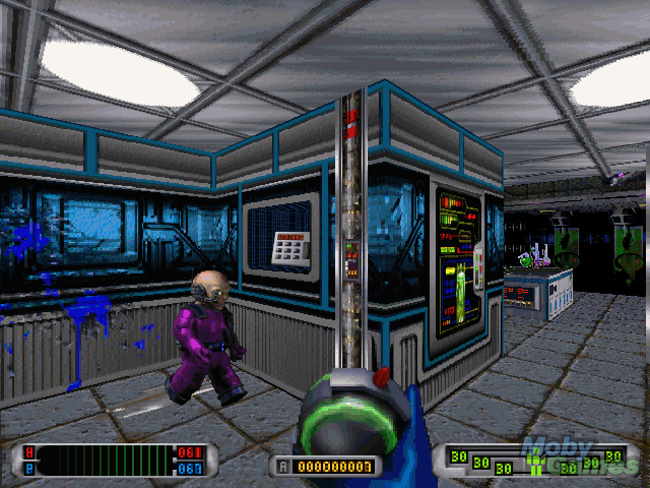
“Don’t you EVER call me shorty!”
GRAPHIC VIOLENCE: As in the case of any elderly game, the looks are hardly a strong point today. The game runs on a half-decent engine from the pre-Quake era, which means pancake-flat characters and blocky, simplistic architecture. That Cybermage manages to convey that much atmosphere using simple level design and low-res textures is quite impressive, although even in its times Cybermage was not without fault. The art direction might have been very cyberpunk and nicely executed, but with the characters the fussy, comic-book feel seems to have gone a bit too far, resulting in individuals that look more like shiny G.I.Joe action figures than living beings. Much less forgivable is the engine’s lamentable lack of stability. Cybermage would very often crash spectacularly with no apparent reason which prompted me to punch the quicksave key way too often for comfort. Amongst many misbehaving games I have sampled, this definitely counted as one of the worst offenders. Sometimes the sound would also die; the soundtrack itself was, again, nothing to complain about in those days, especially since the characters actually spoke, rather than communicate with you through written messages.
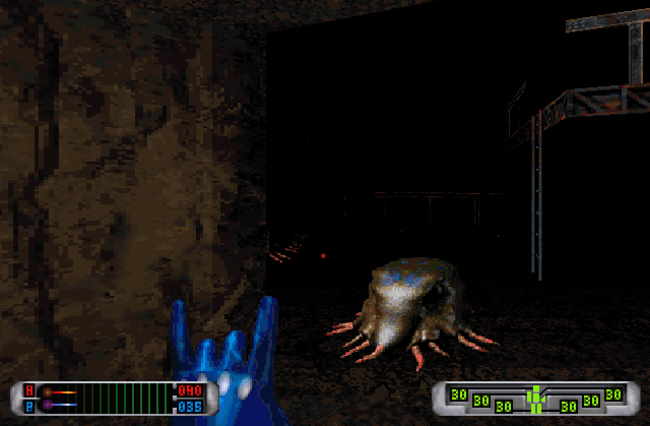
Genetically modified vermin prepare to attack our character but, due to chipset malfunction, he imagines he is actually at a metal gig, judging by the gesture.
The Bottom Line: Cybermage is ultimately a love it or hate it affair. If you find the concept of a comic-book inspired game that follows the exploits of a mutant techno-Gandalf laughable, stay away. Yet if you do make it through the initial strangeness of the concept, you will find a game that is endearingly diverse and packed with intense, non-stop action. It is a stylishly violent, complex and atmospheric game that, a few crashes aside, will keep you glued to the screen. Shame about the massive pixels, then…
This post has been filed under Cyberpunk Games by SFAM.
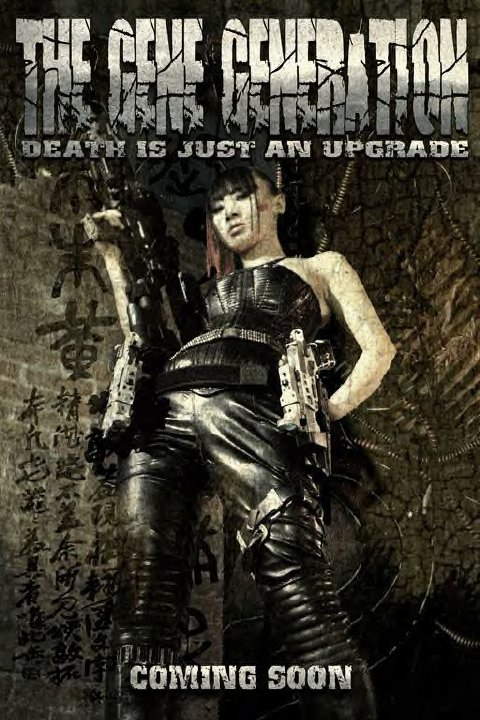
Cyberpunkreview contributor, “Case” has been in discussions with the director for the Gene Generation, a movie coming to theaters this summer. Case passes along a description of the film written by the director himself:
“In the dark decadent world of our future, Mankind has found themselves close to the extinction with the last city on Earth. Forced to implement a controversial Natural Selection process, the government built a wall surrounding the last city named Olympia. By a careful selection process using our genes and DNA, the Kalafkan Government chose only the best and most promising to survive the destruction of Olympia, before building a new city where it once was. This process led to a crime known as DNA Hacking, where people steal genes and DNA in hopes of entering Demeter. The government started hiring assassins, to take out and kill these hackers who have polluted the system. In exchange, the Assassins are granted entry to Demeter. Michelle (Bai Ling) is one of those Assassins. Forced to render her services to the government by any means necessary, Michelle can only hope that death wouldn’t take her soul down like Olympia would. The Gene Generation is a science fiction movie about romance, revenge and redemption”
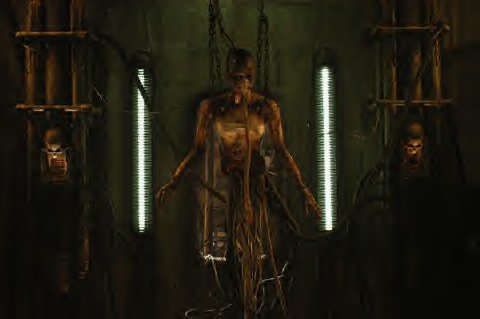
The description certainly sounds pretty close to cyberpunk in themes, and considering that Case is posting this, I’m guessing the film qualifies. In any event, Bai Ling in Black Leathers kicking ass is enough for me to show significant interest! I have no idea the budget involved, but hopefully Case can enlighten us. The Gene Generation stars Bai Ling (one of my favorites! :)), Parry Shen, Alec Newman, and Faye Dunaway, and is directed by Pearry Reginald Teo.
Mr. Teo, best of luck in finalizing your film!
This post has been filed under Upcoming Movies by SFAM.
Movie Review By: SFAM
Year: 2001
Directed by: Steven Spielberg
Written by: Brian Aldiss, Ian Watson & Steven Spielberg
IMDB Reference
Degree of Cyberpunk Visuals: Very High
Correlation to Cyberpunk Themes: High
Key Cast Members:
David: Haley Joel Osment
Gigilo Joe: Jude Law
Monica Swinton: Frances O’Connor
Prof. Hobby, the Visionary: William Hurt
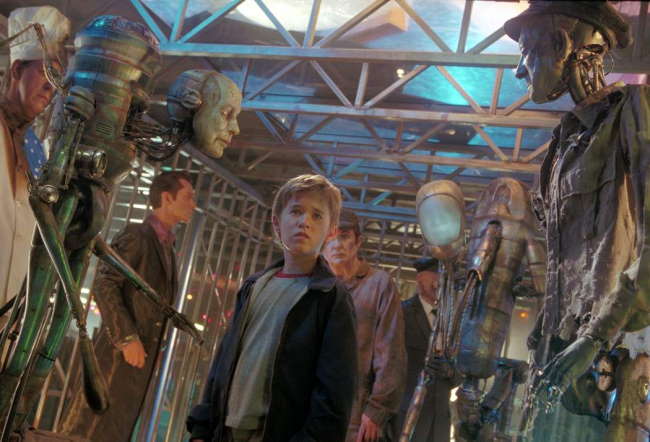
Overview: Originally convieved of by Stanley Kubrick, Spielberg took the reigns of this wonderful Pinocchio tale done in cyberpunk. This story is about a robot who wants to be a “real boy” so that his mother will really love him. Like Pinocchio, he goes on a journey of discovery. Although there are a few over-the-top scenes, the FX is awesome and the acting is wonderful. AI definitely inspires discussion if nothing else.
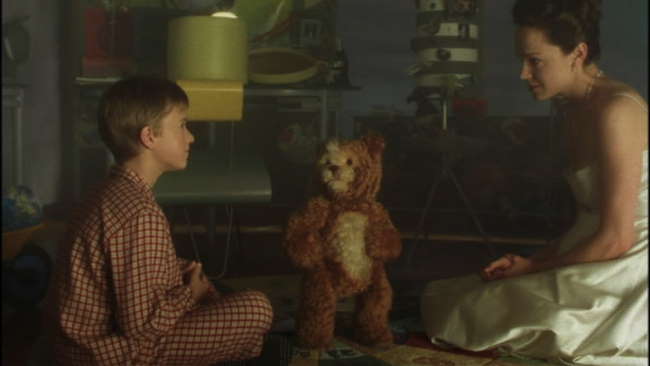
The Story: Set in a near future where global warming has led flooding of all the coasts, and a general breakdown has occurred in many parts of the world. Robots, called Mechas, are common in society now, and perform a variety of functions. Unfortunatley, there is widespread public outcry against their very existence. The focus is on a single family, where a mother has essentially lost her son, who now hangs on to life in cryogenic freeze. Her husband convinces her to get a new model mecha to replace their son – this one becomes hard-wired to its owner and experiences real love and emotion. After accepting their new mecha, a child named David, the family’s life seems complete – until their real son miraculously recovers from his illness.
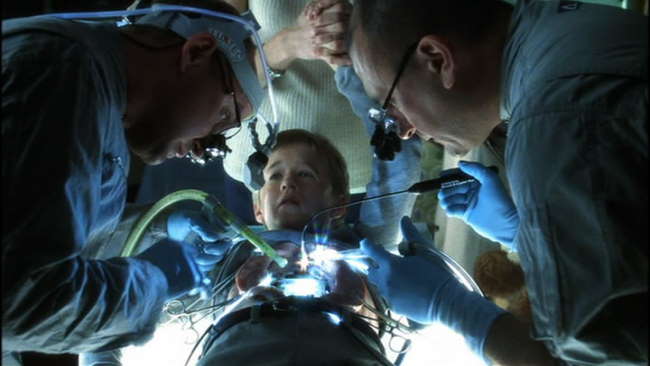
Their real son feels threatened by David, and after a sequence of incidents, David’s mother is forced to send David back to his maker for destruction. But while driving him to his death, she cannot bring herself to follow through, and instead sets him free. In a traumatic breakup, David’s mother warns him of the dangers of the outside world before leaving him alone with just his Teddy toy. David, having been read Pinocchio, decides that if he can find the Blue Fairy, he can convince her to turn him into a “real boy.” Along the way, he encounters Gigilo Joe, who helps him on his journey.
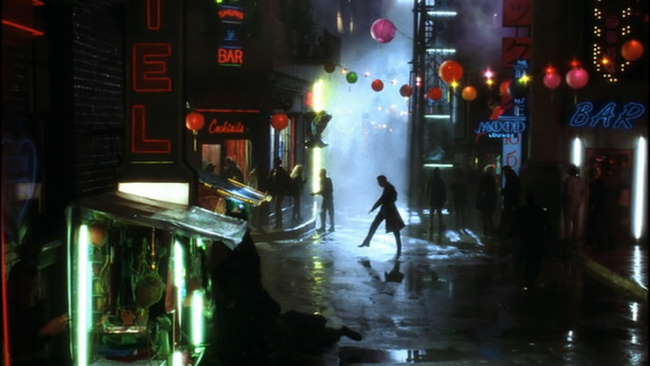
The Acting: The acting in AI is consistently terrific. Haley Joel Osment puts in a performance you’d never expect to see from an actor so young. He is utterly believable both as a mecha, and as his journey proceeds, seemingly transforms into a regular acting boy. Jude Law puts in a terrific performance as Gigilo Joe – one that almost transcends the movie itself as a memorable character. Frances O’Connor also delivers a fine performance as David’s mother, as does William Hurt as David’s inventor.
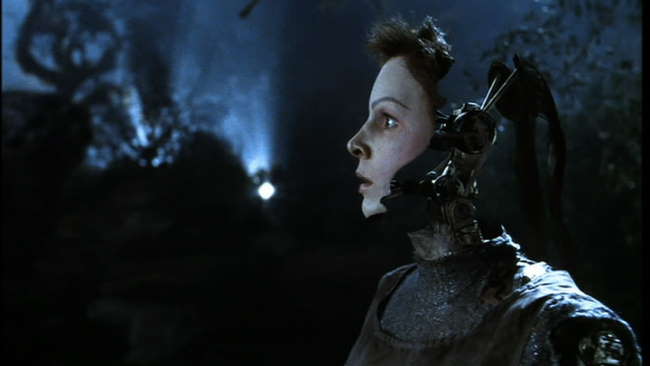
The FX: The visual effects in AI are still among the best that’s ever been put on film. The mechas (robots) look incredibly real – far more real than should be possible. There are many different kinds of mechas, many of which are represented here, but none are better than the Nanny. She is breathtaking. The entire front-end of the movie gives us a very normal set of surroundings. Other than the cars, and minor mecha parts, we aren’t dazzled by the upfront effects. This makes the second half all the more impressive. When David goes outside, things change dramatically. From the robots, to the city-scapes to the destroyed New York, this AI is a visual feast. To top it off, the Teddy Bear is maybe my favorite robot character of all movies.
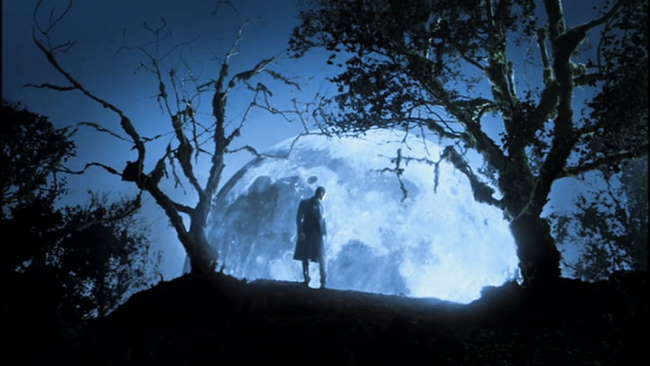
The Score: John Williams is as awesome as ever in creating the score for AI. He is able to capture the feeling of the dregs of humanity along with an almost heavenly sense of love and contentment. The score really brings the movie together in places that with something lessor it might not have worked.
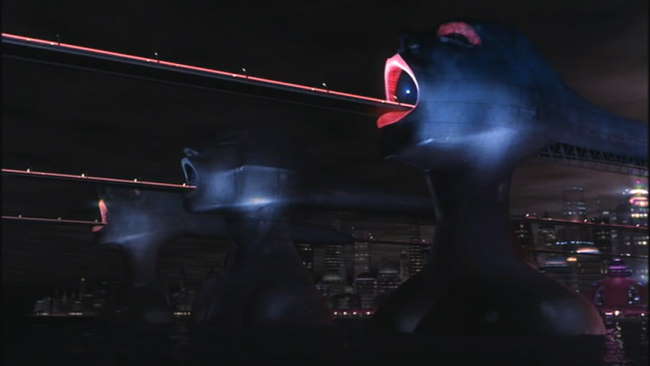
Kubrick versus Spielberg: AI is a strange movie in that it encapsulates a harsh Kubrick-style future while at the same time has a story that lends itself to Spielberg’s Capra-like tendency for the emotional mushiness. In watching AI, rarely do the two tendencies meet up well. We either have the dystopic craziness of the Flesh Fair or the serenity of the beginning. We also see dramatic changes in pacing. In some parts, we have a very slow, deliberate movie, whereas in others, it seemingly breezes past key scenes.
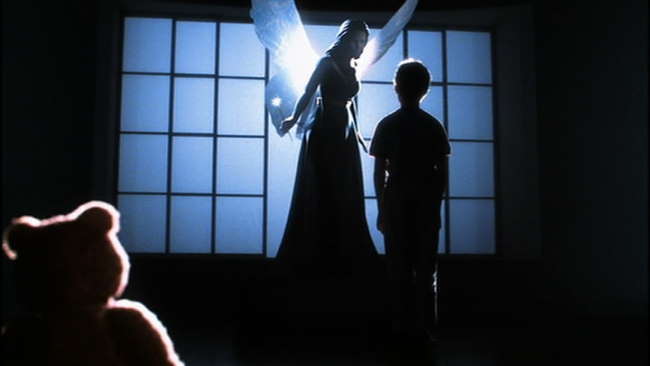
Some thoughts on the ending: Many folks who generally like the movie end up hating the ending. I don’t have this issue - in fact I like the ending, but I do understand the sentiment. The ending really does drop into a completely different movie altogether. In effect, it becomes the fairy tale that David pursues the entire movie. But because I KNOW the ending engenders discussion, I am concerned about spoilers in the comments below. PLEASE don’t post spoiler thoughts - if you do, your comment will be deleted. Instead, I’ve created a thread in the meatspace to discuss the ending of AI.
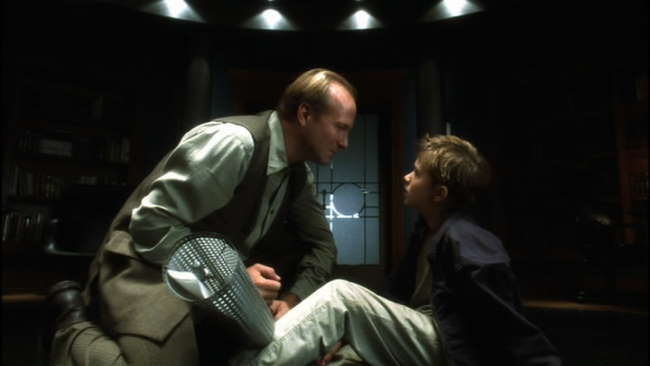
The Bottom Line: AI is a visual feast of dystopia and human morals run amok. As the same time, it’s a beautiful love story about the best of humanity. Many have issues with the ending, although, it works fine for me. While the actions in the Flesh Fair are bit outside believability, overall, the story is very well done. The CG is among the best ever on film (check out page 2 below if you want to see more screencaps). It doesn’t serve to astonish us, but instead, attempts to integrated seemlessly into the film. The acting is terrific, especially from Haley Joel Osment (David the robot boy) and Jude Law (Gigolo Joe). On top of this, we get a very interesting portrayal of a future with sentient robots who do not have any rights. One can almost see the Animatrix’s Rennaissance occurring shortly afterwards.
Go to AI, Page 2: More Screencaps –>>
~See movies similar to this one~
WordPress database error: [You have an error in your SQL syntax; check the manual that corresponds to your MySQL server version for the right syntax to use near '' at line 1]
SELECT COUNT(ID) FROM
|






































